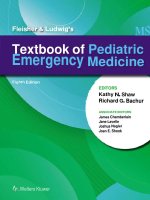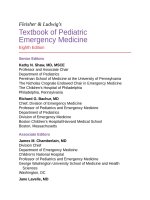Pediatric emergency medicine trisk 0222 0222
Bạn đang xem bản rút gọn của tài liệu. Xem và tải ngay bản đầy đủ của tài liệu tại đây (111.52 KB, 1 trang )
older children (9 to 18 years old) had an incidence of an initial shockable rhythm
similar to that of adults (32%).
TABLE 9.7
PRESENTING RHYTHM IN PEDIATRIC PATIENTS WITH OUT-OFHOSPITAL CARDIOPULMONARY ARREST AND IN-HOSPITAL
CARDIOPULMONARY ARREST (%)
Defibrillation is the asynchronous delivery of a shock to the myocardium in an
attempt to produce simultaneous depolarization of a critical mass of myocardial
cells to allow spontaneous repolarization and the resumption of a perfusing
cardiac rhythm. Most defibrillators deliver biphasic wave forms, allowing for
successful defibrillation at a lower energy of 150 J. Standard adult paddles, 8 to
13 cm in diameter and pediatric paddles 4.5 cm in diameter, are available with
most defibrillators. The correct paddle size is that which makes complete uniform
contact with the chest wall. The large paddle can usually be used for infants older
than 1 year of age and/or weighing more than 10 kg. Larger paddle surfaces result
in decreased intrathoracic impedance and optimize the energy reaching the
myocardium. Electrode paste decreases impedance and prevents skin injury.
Paddles are applied anteriorly at the right upper chest below the clavicle and to
the left of the nipple in the anterior axillary line directly over the heart; they are
applied with pressure and should never touch each other. Most defibrillators also
have disposable hands-free adhesive pads that allow both rhythm recognition and
shock delivery. These can be applied in the same location on the arrested child, or









